
The Baltic states or the Baltic countries is a geopolitical term encompassing Estonia, Latvia, and Lithuania. All three countries are members of NATO, the European Union, the Eurozone, and the OECD. The three sovereign states on the eastern coast of the Baltic Sea are sometimes referred to as the "Baltic nations", less often and in historical circumstances also as the "Baltic republics", the "Baltic lands", or simply the Baltics.
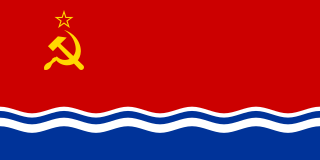
The Latvian Soviet Socialist Republic, also known as Soviet Latvia or simply Latvia, was a republic in the Soviet Union. The Latvian SSR existed for over 50 years, from 5 August 1940 to 6 September 1991.
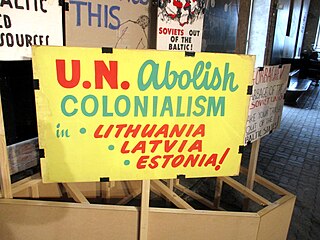
The three independent Baltic countries – Estonia, Latvia, and Lithuania – were invaded and occupied in June 1940 by the Soviet Union, under the leadership of Stalin and auspices of the Molotov–Ribbentrop Pact that had been signed between Nazi Germany and the Soviet Union in August 1939, immediately before the outbreak of World War II. The three countries were then annexed into the Soviet Union in August 1940. The United States and most other Western countries never recognised this incorporation, considering it illegal. On 22 June 1941, Nazi Germany attacked the Soviet Union and within weeks occupied the Baltic territories. In July 1941, the Third Reich incorporated the Baltic territory into its Reichskommissariat Ostland. As a result of the Red Army's Baltic Offensive of 1944, the Soviet Union recaptured most of the Baltic states and trapped the remaining German forces in the Courland Pocket until their formal surrender in May 1945.

Jüri Uluots was an Estonian prime minister, journalist, prominent attorney and distinguished Professor and Dean of the Faculty of Law at the University of Tartu.

During World War II, in the course of Operation Barbarossa, Nazi Germany invaded Estonia in July–December 1941, and occupied the country until 1944. Estonia had gained independence in 1918 from the then warring German and Russian Empires. However, in the wake of the August 1939 Nazi-Soviet Pact, the Stalinist Soviet Union had invaded and occupied Estonia in June 1940, and the country was formally annexed into the USSR in August 1940.

The military occupation of Latvia by Nazi Germany was completed on July 10, 1941, by Germany's armed forces. Initially, the territory of Latvia was under the military administration of Army Group North, but on 25 July 1941, Latvia was incorporated as Generalbezirk Lettland, subordinated to Reichskommissariat Ostland, an administrative subdivision of Nazi Germany. Anyone not racially acceptable or who opposed the German occupation, as well as those who had cooperated with the Soviet Union, were killed or sent to concentration camps in accordance with the Nazi Generalplan Ost.
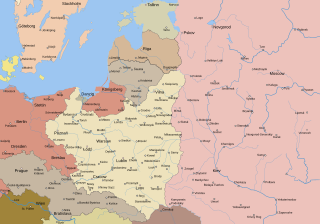
After the occupation of Latvia by the USSR in June 1940, much of the previous Latvian army was disbanded and many of its soldiers and officers were arrested and imprisoned or executed. The following year Nazi Germany occupied Latvia during the offensive of Army Group North. The German Einsatzgruppen were aided by a group known as Arajs Kommando in the killing of Latvian Jews as part of the Holocaust. Latvian soldiers fought on both sides of the conflict against their will, and in 1943 180,000 Latvian men were drafted into the Latvian Legion of the Waffen-SS and other German auxiliary forces.
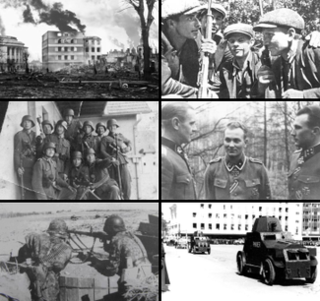
Estonia declared neutrality at the outbreak of World War II (1939–1945), but the country was repeatedly contested, invaded and occupied, first by the Stalinist Soviet Union in 1940, then by Nazi Germany in 1941, and ultimately reinvaded and reoccupied in 1944 by the Soviet Union.
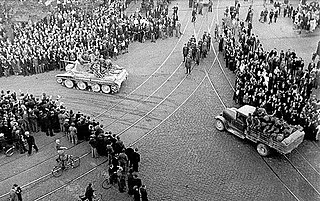
The Soviet occupation of Latvia in 1940 refers to the military occupation of the Republic of Latvia by the Soviet Union under the provisions of the 1939 Molotov–Ribbentrop Pact with Nazi Germany and its Secret Additional Protocol signed in August 1939. The occupation took place according to the European Court of Human Rights, the Government of Latvia, the United States Department of State, and the European Union. In 1989, the USSR also condemned the 1939 secret protocol between Nazi Germany and herself that had led to the invasion and occupation of the three Baltic countries, including Latvia.

The military occupation of Lithuania by Nazi Germany lasted from the German invasion of the Soviet Union on June 22, 1941, to the end of the Battle of Memel on January 28, 1945. At first the Germans were widely welcomed as liberators from the repressive Soviet regime which occupied Lithuania prior to the German arrival. In hopes of re-establishing independence or regaining some autonomy, Lithuanians organized a Provisional Government. Thousands of Lithuanian nationalists then cooperated with the Generalkommissariat, jointly killing almost 200,000 Jews, which marks the highest death rate proportionally in any country during the Holocaust.

Relevant events began regarding the Baltic states and the Soviet Union when, following Bolshevist Russia's conflict with the Baltic states—Lithuania, Latvia and Estonia—several peace treaties were signed with Russia and its successor, the Soviet Union. In the late 1920s and early 1930s, the Soviet Union and all three Baltic States further signed non-aggression treaties. The Soviet Union also confirmed that it would adhere to the Kellogg–Briand Pact with regard to its neighbors, including Estonia and Latvia, and entered into a convention defining "aggression" that included all three Baltic countries.
The timeline of the occupation of the Baltic states lists key events in the military occupation of the three countries – Estonia, Latvia and Lithuania – by the Soviet Union and by Nazi Germany during World War II.

The background of the occupation of the Baltic states covers the period before the first Soviet occupation on 14 June 1940, stretching from independence in 1918 to the Soviet ultimatums in 1939–1940. Lithuania, Latvia, and Estonia gained independence in the aftermath of the Russian revolutions of 1917 and the German occupation which in the Baltic countries lasted until the end of World War I in November 1918. All three countries signed non-aggression treaties with the Soviet Union in the 1920s and 1930s. Despite the treaties, in the aftermath of the 1939 German–Soviet pact, Estonia, Latvia and Lithuania were occupied, and thereafter forcibly incorporated into the Soviet Union, in 1940.

The three Baltic states – Estonia, Latvia and Lithuania – were re-occupied in 1944–1945 by the Soviet Union (USSR) following the German occupation. The Baltic states regained independence in 1990–1991.

The Soviet occupation of the Baltic states covers the period from the Soviet–Baltic mutual assistance pacts in 1939, to their invasion and annexation in 1940, to the mass deportations of 1941.

The Soviet Union (USSR) occupied most of the territory of the Baltic states in its 1944 Baltic Offensive during World War II. The Red Army regained control over the three Baltic capitals and encircled retreating Wehrmacht and Latvian forces in the Courland Pocket where they held out until the final German surrender at the end of the war.
Generalbezirk Estland was one of the four administrative subdivisions of Reichskommissariat Ostland, the 1941-1945 civilian occupation regime established by Nazi Germany for the administration of the three Baltic countries and the western part of the Byelorussian SSR.
Generalbezirk Lettland was one of the four administrative subdivisions of Reichskommissariat Ostland, the civilian occupation regime established by Nazi Germany for the administration of the Baltic States and the western part of the Byelorussian Soviet Socialist Republic.
Wartime collaboration occurred in every country occupied by Nazi Germany during the Second World War, including the Baltic states. The three Baltic republics of Estonia, Latvia and Lithuania, first invaded and occupied by the Soviet Union in summer 1940, were later occupied by Germany in summer 1941 and incorporated, together with parts of the Byelorussian Soviet Socialist Republic of the U.S.S.R., into Reichskommissariat Ostland. Collaborators with Germany participated in the Eastern Front against the Soviet Union, as well as in the Holocaust, both in and outside of the Baltic States. This collaboration was done through formal Waffen-SS divisions and police battalions, as well as through spontaneous acts during the opening of the war.
















